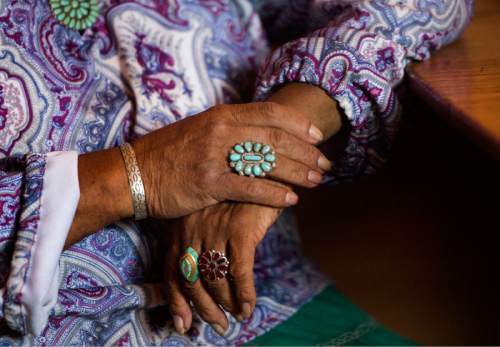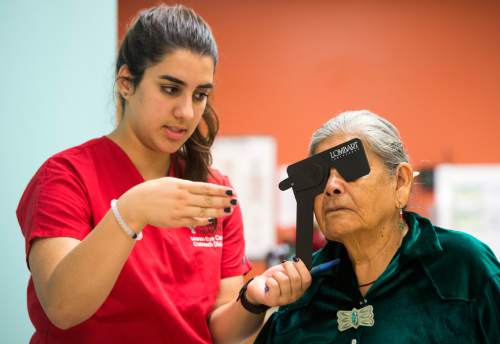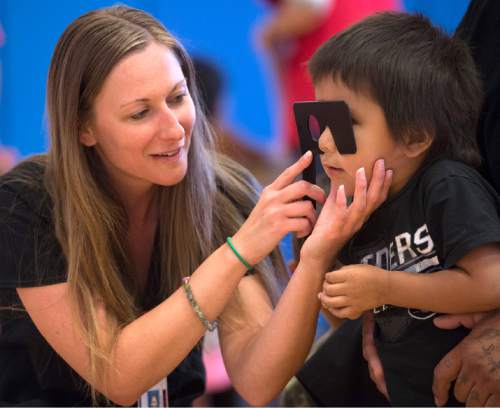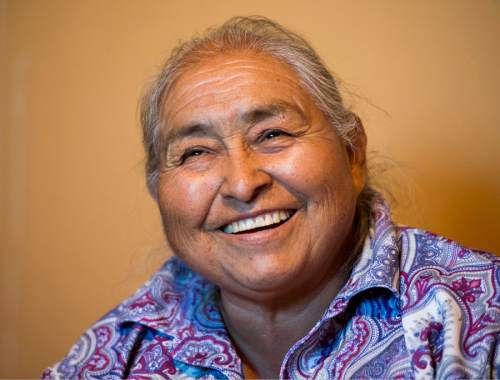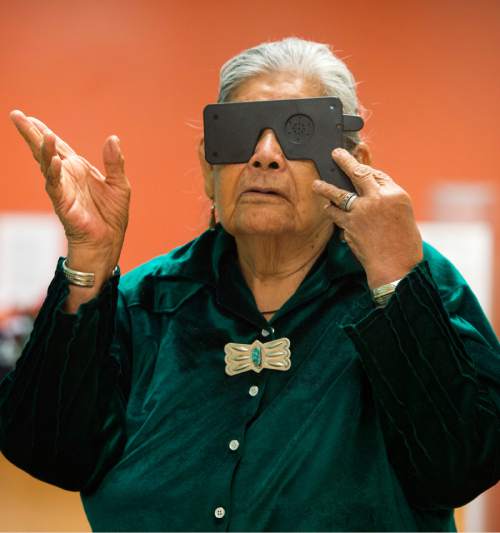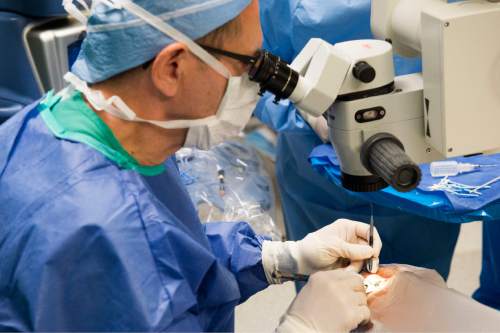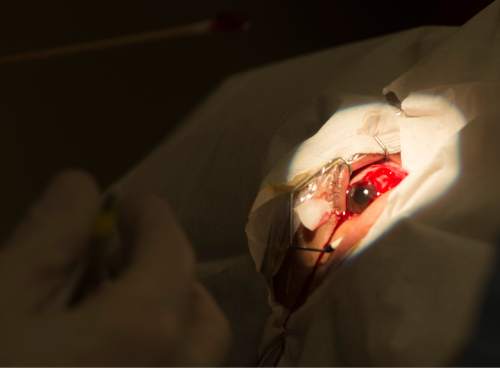This is an archived article that was published on sltrib.com in 2015, and information in the article may be outdated. It is provided only for personal research purposes and may not be reprinted.
Navajo Mountain • Violet Smith has just learned she needs surgery to remove a pterygium, the buildup of white scar tissue blurring the vision in her left eye. Her sister-in-law, Judy Yazzie, awaits what likely will be a similar diagnosis.
So Michael Yei, manager of the Moran Eye Center's outreach division, is giving them a hard time.
"What's wrong with you guys? Huh? What have you been up to with your eyes?"
Yei jokes because he knows the answer. Pterygia are common among Navajos, who live where sunshine and dust are ubiquitous.
"It [the scar tissue] pinches and distorts your cornea. We're going to get rid of it and then get you new glasses. And then what are you going to do every day when you're out?" he asks Smith, 57, a van driver for the LeChee Senior Center near Page, Ariz.
"Wear a big sombrero!" she answers, prompting raucous laughter from her granddaughters and Yei and Yazzie.
Smith, granddaughters Trulita and Trumanalita Bitsoie, and Yazzie are among the 127 Navajos who have shown up this Saturday at the remote Navajo Mountain High School for eye exams.
Teams from the Moran center at the University of Utah have been coming here and to other parts of the Utah strip of the Navajo Nation for more than two years, examining eyes that had rarely been examined, distributing eyeglasses and performing surgeries, all for free.
In the past, many would see an eye doctor at the Indian Health Service clinic in Kayenta or off the reservation, but they often couldn't fill a prescription for glasses or contacts because of cost, or the distance to an optical shop. Those prescribed surgery typically didn't have the money or ability to travel hundreds of miles.
The regular eye care is making a difference in the lives of Utah Navajos and their Arizona neighbors, health care providers say.
Uncorrected vision problems are "a major cause of trouble" for children, says Robert Hoffman, chief of pediatric ophthalmology at Moran and Primary Children's Hospital. Utah's schools on the Navajo reservation consistently have low test scores, and Hoffman believes poor vision may be one reason.
Now, many Navajo children have been fitted with glasses.
And though Navajos have accepted the fact that many will go blind, much of the blindness is preventable, says Shawn Begay, manager of the Utah Navajo Health Systems' clinics in Monument Valley and Navajo Mountain.
"Around here, people just got used to it, like it's just part of life, part of getting old," Begay says. "But in reality, it doesn't have to happen."
—
Long time coming • Navajo Mountain, population 354, is one of Utah's most remote communities. It's over the mountain from Lake Powell's Rainbow Bridge, but to get there, one must drive to Page or Kayenta, Ariz., and then drive 94 miles or 86 miles, respectively.
Of the 175,000 Navajos living on the reservation, 6,000 live in Utah. Nearly half have incomes below the poverty line.
"This is like a third-world place in the middle of the United States," says Alan Crandall, co-director of Moran's Global Outreach Division, which operates entirely on donations.
On this trip, Crandall and his son, David Crandall, a Michigan ophthalmologist, removed four cataracts for Navajos at the Blue Mountain Hospital in Blanding, and then examined dozens of patients' eyes the next day at Navajo Mountain.
A Moran team of two or three dozen employees, family members and other volunteers comes 11 times a year. Most of them take vacation days to do so, and the doctors charge no fees.
The team goes to the biggest public spaces, schools in three Navajo communities — Navajo Mountain, Monument Valley and Montezuma Creek — to examine the eyes of Navajos of all ages. Those who need glasses get them the following month, and those who need cataract or pterygium surgery are given appointments for the next month as well. The Moran team sets up shop at its partner institutions, the Blanding hospital or a clinic in Monument Valley, for the surgeries.
Gordon Warren and Loretta King of Navajo Mountain brought three of their five boys to Navajo Mountain High School for eye exams. It's been 18 months since two of the boys were last examined, when the family lived in Phoenix. Both are supposed to see eye specialists every six months, and one has a broken pair of glasses, King says.
"We moved back [to Navajo Mountain] and it makes it hard for us to see specialists," she says, adding that the Moran team's visit saves the family a three- or four-hour trip to Phoenix.
Tristan Warren, 2, also gets his eyes examined for the first time and his parents are happy with the news. He doesn't yet need glasses.
—
Communication is key • Providing regular eye care here is not easy because few have home phones, cellphone coverage is spotty, and it's hard to get places on this vast reservation.
This is why Yei, on the move since 5 a.m. on the first day of this outreach trip, is visiting the home of Frances and Kee Parrish early in the evening.
The Parrishes both had cataracts removed from both eyes earlier this year, but have not made their follow-up visits. They live about 10 miles from Kayenta, much of it on a rutted dirt road, and have to walk to the top of a hill to get cell service.
Follow-up visits after surgery are important so patients' eyes can be re-examined and eyeglasses can be provided to correct what the surgery couldn't.
Yei has brought along his friend, Toni Dee, to translate because the Parrishes speak only Navajo. Dee is a hospice nurse based in Bluff.
Kee, 70, who worked in the uranium mines and now has lung problems, says he can shoot his gun again and even hunt rabbits or deer, if he is of a mind to do that.
Frances, 68, tells Yei that her vision is good enough now to thread a needle or allow her to drive to Farmington, N.M., or Cortez, Colo., but she still sees double when looking in the distance, especially at night.
"It's an eye muscle thing," Yei tells her, adding that the glasses she'll get at follow-up visits will fix that problem.
"If she can come, the prism will correct that," he says.
It's still an improvement from the partial blindness the cataracts were causing. Without the Moran folks, says Frances, "We would have to live with it."
Frances and Yei settle on a communication plan: Yei will send a reminder of an October appointment to the couple's post office box in Kayenta.
The group shares pleasantries for a while. "You look as cute as ever," Yei tells them.
"It's nice to see you guys again," says Frances.
Yei, who initiated the outreach to the Navajos after he joined Moran, says communication and transportation are the two biggest obstacles to providing good eye care here.
On Moran's September trip to the reservation, for example, only four of the 12 who had appointments for cataract surgery made it to the Blanding hospital.
—
"Exactly where I belong" • Some do follow up.
Lucy Cly, 78, stands in the hallway of the Monument Valley clinic, holding her hand in front of one eye and then the next as Moran techs ask what she can see on the eye chart.
The team removed a cataract from her left eye in July, says Traci Cly, her daughter-in-law, driver and translator. Lucy was expecting to receive her new glasses this day, but instead must wait a few days because of a delivery problem.
Lucy wears the traditional clothing of older Navajo women: a long printed skirt, a velveteen long-sleeved shirt, turquoise and silver bracelets, and a brooch. The stick in her bun is beaded.
"She couldn't see little words or screens," says Traci.
Now Lucy can see well enough to sew and do beadwork again, Traci says.
Around the corner and down the hall, Susan MacDonald, an ophthalmologist from Tufts University and the Lahey Hospital and Medical Center in Boston, reassures Frieda Crank, 65, who lies on the surgical table with a cover over her head. One of her eyes is exposed and lit by a bright light.
"We're almost done, so hang in there, my darlin',' " MacDonald says, wielding a medical instrument but putting Crank at ease. "Sorry I took my sweet little time, but it looks gorgeous. I just wanted to get rid of that growth."
Crank, who lives in Oljato in Monument Valley, is one of four patients having pterygia removed this day.
"I just wanted to get rid of that growth," she says later, echoing the doctor. "It's blurry and it looks funny."
MacDonald, who has traveled with Moran teams to Kenya, Guatemala and Haiti in the past couple of years, says when she is volunteering her time, "I feel I'm exactly where I belong."
MacDonald did her residency at the U. and considers Crandall her mentor.
"We're doing something amazing — restoring vision in communities where they don't have access to care."
—
Looking forward • Over at Tse'bii'nidzisgai Elementary, Moran's Lori McCoy is fitting child after child for glasses.
"We're going to get you some glasses," she tells 6-year-old Rikeya Barlow. "What is your favorite color? Pink, blue, black, yellow, purple?"
Eventually, Barlow settles on a pair of black plastic rectangular frames that are a perfect fit for her small face.
On this trip, all 70 children examined at Tse'bii'nidzisgai Elementary and Navajo Mountain are prescribed glasses.
Vision problems can affect a child's brain development and are harder to correct the longer one waits, Hoffman says.
"They're looking at a lifetime of poor vision, which isn't going to instantly get better when you put glasses on them as an adult," he says.
He's hopeful that by providing eye care to younger children — he and a colleague screened an infant at Tse'bii'nidzisgai on this trip — things will turn around for Utah's Navajo children.
And Yei is looking at what more can be done now that the Moran team has finessed the logistics of such outreach trips.
He'd like to set up a permanent laser machine at one of the Utah Navajo Health System's clinics to treat diabetic retinopathy, a common malady among Navajo adults, 22 percent of whom have diabetes.
At present, some patients with glaucoma, macular degeneration or diabetic retinopathy travel to Salt Lake City, on Moran's dime, for treatment. But it's expensive and difficult for Navajo families.
Yei also harbors an ambitious goal: to bring together all the organizations involved in Navajo health throughout the Southwest to create a unified, coordinated eye-care system.
"There is a lot of need overseas, but there is a lot of need here," he says. "I think we can transform eye care."
kmoulton@sltrib.com Twitter: @KristenMoulton —
Moran Eye Center Outreach
The Moran Eye Center has been sending out teams internationally since 1994. Several times a year, they go to such countries as Bhutan, South Sudan or Guatemala. In August, for instance, the team was in Haiti, and was joined by Sen. Rand Paul of Kentucky, an ophthalmologist and candidate for president. It was his second trip with the Moran team. For more than two years, teams have been going to the Navajo Reservation 11 times a year.
The Moran outreach teams typically remove 100 cataracts a year for Navajos, and supply anywhere from 600 to 900 pair of eyeglasses, a third of them to schoolchildren. Moran physicians, nurses and technicians, as well as guest volunteers, donate their time. But the cost for each trip amounts to $7,000 to $9,000, all covered by donations.






